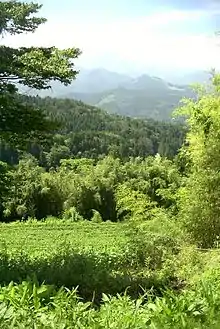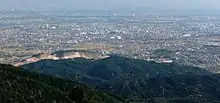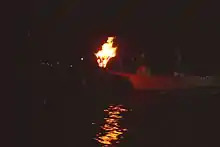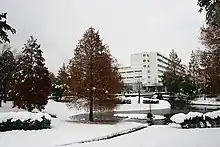Gifu Prefecture
岐阜県 | |
|---|---|
| Japanese transcription(s) | |
| • Japanese | 岐阜県 |
| • Rōmaji | Gifu-ken |
 | |
 Flag  Symbol | |
| Anthem: Gifu kenmin no uta | |
 | |
| Country | |
| Region | Chūbu (Tōkai) |
| Island | Honshu |
| Capital | Gifu |
| Subdivisions | Districts: 9, Municipalities: 42 |
| Government | |
| • Governor | Hajime Furuta |
| Area | |
| • Total | 10,621.29 km2 (4,100.90 sq mi) |
| • Rank | 7th |
| Population (June 1, 2019) | |
| • Total | 1,991,390 |
| • Rank | 17th |
| • Density | 190/km2 (490/sq mi) |
| GDP | |
| • Total | JP¥ 7,937 billion US$ 72.8 billion (2019) |
| ISO 3166 code | JP-21 |
| Website | www |
| Symbols of Japan | |
| Bird | Rock ptarmigan (Lagopus muta) |
| Fish | Ayu (Plecoglossus altivelis) |
| Flower | Chinese milk vetch (Astragalus sinicus) |
| Tree | Japanese yew (Taxus cuspidata) |
Gifu Prefecture (岐阜県, Gifu-ken) is a prefecture of Japan located in the Chūbu region of Honshu.[2]: 246 [3]: 126 Gifu Prefecture has a population of 1,991,390 (as of 1 June 2019) and has a geographic area of 10,621 square kilometres (4,101 sq mi). Gifu Prefecture borders Toyama Prefecture to the north; Ishikawa Prefecture to the northwest, Fukui Prefecture and Shiga Prefecture to the west, Mie Prefecture to the southwest, Aichi Prefecture to the south, and Nagano Prefecture to the east.
Gifu is the capital and largest city of Gifu Prefecture, with other major cities including Ōgaki, Kakamigahara, and Tajimi.[4]: 246
Gifu Prefecture is located in the center of Japan, one of only eight landlocked prefectures, and features the country's center of population. Gifu Prefecture has served as the historic crossroads of Japan with routes connecting the east to the west, including the Nakasendō, one of the Five Routes of the Edo period. Gifu Prefecture was a long-term residence of Oda Nobunaga and Saitō Dōsan, two influential figures of Japanese history in the Sengoku period, spawning the popular phrase "control Gifu and you control Japan" in the late Medieval era.[5] Gifu Prefecture is known for its traditional Washi paper industry, including Gifu lanterns and Gifu umbrellas, and as a center for the Japanese swordsmithing and cutlery industries. Gifu Prefecture is home to Gifu Castle, the 1,300-year-old tradition of Cormorant fishing on the Nagara River, and the site of the Battle of Sekigahara.
History
The land area that makes up modern-day Gifu became part of the Yamato Court around the middle of the fourth century. Because it is in the middle of the island of Honshu, it has been the site of many decisive battles throughout Japan's history, the oldest major one being the Jinshin War in 672, which led to the establishment of Emperor Tenmu as the 40th emperor of Japan.
The area of Gifu Prefecture consists of the old provinces of Hida and Mino, as well as smaller parts of Echizen and Shinano.[6] The name of the prefecture derives from its capital city, Gifu, which was named by Oda Nobunaga during his campaign to unify all of Japan in 1567.[7] The first character used comes from Qishan (岐山), a legendary mountain from which most of China was unified, whereas the second character comes from Qufu (曲阜), the birthplace of Confucius.[8] Nobunaga chose those characters because he wanted to unify all of Japan and he wanted to be viewed as a great mind.
Historically, the prefecture served as the center of swordmaking for the whole of Japan, with Seki being known for making the best swords in Japan. More recently, its strengths have been in fashion (primarily in the city of Gifu) and aerospace engineering (Kakamigahara).
On October 28, 1891, the present-day city of Motosu was the epicenter for the Mino–Owari earthquake, the second largest earthquake to ever hit Japan.[9] The earthquake, estimated at 8.0 (surface-wave magnitude), left a fault scarp that can still be seen today.
Geography
One of the few landlocked prefectures in Japan, Gifu shares borders with seven other prefectures: Toyama, Ishikawa, Fukui, Shiga, Mie, Aichi, and Nagano. Japan's postal codes all start with a three-digit number, ranging from 001 to 999. Part of Gifu has the 500 prefix, reflecting its location in the center of Japan. The center of Japanese population is currently located in Seki City, Gifu Prefecture. The center of population is a hypothetical point at which a country is perfectly balanced assuming each person has a uniform weight. The spot was calculated using the 2005 census.
As of 31 March 2019, 18 percent of the total land area of the prefecture was designated as Natural Parks, namely the Hakusan and Chūbu-Sangaku National Parks, Hida-Kisogawa and Ibi-Sekigahara-Yōrō Quasi-National Parks, and fifteen Prefectural Natural Parks.[10]
Regions
Gifu has five unofficial regions, which allows local municipalities to work together to promote the surrounding area. The five regions are Seinō,[11] Gifu,[12] Chūnō,[13] Tōnō[14] and Hida.[15] The borders of the regions are loosely defined, but they are usually delineated among major cities.
Topography
The northern Hida region is dominated by tall mountains, including parts of the Japanese Alps. The southern Mino region is mostly parts of the fertile Nōbi Plain, a vast plains area with arable soil. Most of the prefecture's population lives in the southern part of the prefecture, near the designated city of Nagoya.
The mountainous Hida region contains the Hida Mountains, which are referred to as the "Northern Alps" in Japan. The Ryōhaku Mountains are also in the Hida region. Other major ranges include the Ibuki Mountains and the Yōrō Mountains.
Much of the Mino region is made up of the alluvial plain of the Kiso Three Rivers, which are the Kiso River, Nagara River and Ibi River. The sources of Kiso river is in Nagano prefecture, and those of the others are in Gifu prefecture. They eventually run through Aichi and Mie prefectures before emptying into Ise Bay. Other major rivers in the prefecture include the Miya, Takahara, Shō, Toki (Shōnai), Yahagi, and Itoshiro rivers.
Climate

Gifu's climate varies from humid subtropical climate in the south, eventually making the transition to humid continental climate in the north.
Because the Mino region is surrounded by low mountains, the temperature fluctuates through the year, from hot summers to cold winters. The eastern city of Tajimi, for example, often records the hottest temperature in Japan each year and is considered to be the hottest city within Honshu boasting an average daytime high of 34.1 °C (93.4 °F) during the peak of summer. On August 16, 2007, Tajimi set the record for the hottest day recorded in Japan's history—40.9 °C (105.6 °F).[16] Summers are hotter, as the landlocked area becomes a heat island, and the temperature rises even further when hot, dry foehn winds blow over the Ibuki Mountains from the Kansai region. The Hida region, with its higher elevation and northerly latitude, is significantly cooler than the Mino region, although there are sometimes extremely hot days there too. The Hida region is more famous for its harsh winters, bringing extremely heavy snowfall, especially in the northwestern areas. Gifu boasts a high amount of skiing locations. Shōkawa-chō, part of the city of Takayama, is up in the mountains, and its location has led it to be called the coldest inhabited place on Honshū.
Gifu City (Mino Region)
| ||||||||||||||||||||||||||||||||||||||||||||||||||||||||||||||||||||||||||||||||||||||||||||||||||||||||||||||||||||||||||||||||||||||||||||||||||||||||||||||||||||||||||||||||||||||||||||||||||||
Hida Takayama (Hida Region)
| ||||||||||||||||||||||||||||||||||||||||||||||||||||||||||||||||||||||||||||||||||||||||||||||||||||||||||||||||||||||||||||||||||||||||||||||||||||||||||||||||||||||||||||||||||||||||||||||||||||
Shōkawa, Takayama (Hida Region)
| ||||||||||||||||||||||||||||||||||||||||||||||||||||||||||||||||||||||||||||||||||||||||||||||||||||||||||||||||||||||||||||||||||||||||||||||||||||||||||||||||||||||||||||||||||||||||||||||||||||
Municipalities

City Town Village
All of the cities, towns, villages and districts of Gifu Prefecture are listed below.
Cities
Twenty-one cities are located in Gifu Prefecture:



- Gifu – (the capital city of the prefecture)
Towns and villages
These are the towns and villages in each district:
Mergers
Economy
Traditional industries such as paper-making and agriculture are found in Gifu, but its economy is dominated by the manufacturing sector including aerospace and automotive, with industrial complexes extending from the Nagoya area. A wealth of small component manufacturing is also found, such as precision machines, dye and mold making, and plastic forming.
Traditional industries

Gifu is famous for cormorant fishing, which has a history of over 1,300 years. Agriculture is also a major industry because of Gifu's vast, arable plains. The forests in the north provide materials for woodworking and for the viewing boats used in cormorant fishing.
The Mino region has long been known for its high-quality paper called Mino washi, which is stronger and thinner than most other papers in Japan, and was used by the Japanese military during World War II.[23] Other paper-based products include Gifu Lanterns and Gifu Umbrellas, made in the prefectural capital of Gifu. Other traditional goods include mino-yaki pottery in Tajimi, Toki, and Mizunami, cutlery in Seki, and lacquerware in Takayama. Sake is often brewed with clear water from the rivers.
Modern industries
Kakamigahara has a large role in the prefecture's modern industries. It boasts large aerospace facilities of both Kawasaki Heavy Industries and Mitsubishi Heavy Industries, as well as many metalworking and manufacturing companies.
Information technology (IT) is gaining a foothold in the prefecture with both Softopia Japan in Ōgaki and VR Techno Japan (part of Techno Plaza) in Kakamigahara. The capital city of Gifu, located between Ōgaki and Kakamigahara, is also working to strengthen its IT fields, too.
Tourism

Gifu has many popular tourist attractions, bringing visitors to all parts of the prefecture. The most popular places are Gifu, Gero, Shirakawa and Takayama. Gero is known for its relaxing hot springs, which attract visitors throughout the year. Shirakawa's historic villages are a UNESCO World Heritage Site. Takayama is famous for retaining its original appearance and is often referred to as Little Kyoto.
In addition to international tourists, Gifu also plays host to many international events. The World Event and Convention Complex Gifu is available for many types of events. Other areas of Gifu, too, bring international events. The World Rowing Championships were held in the city of Kaizu in 2005. The FIS Snowboard World Cup was held in the city of Gujo in 2008. The APEC Japan 2010 SME Ministerial Meetings were held in Gifu City.
Science
The Kamioka area of the city of Hida is home to the Kamioka Observatory underground laboratory. Located 1,000 m (3,281 ft) underground in Kamioka Mining and Smelting Co.'s Mozumi Mine, the Super-Kamiokande experiment searches for neutrinos from the high atmosphere, the sun and supernovae, while the KamLAND experiment searches for antineutrinos from regional nuclear reactors. The Super-Kamiokande consists of a cylindrical stainless steel tank that is 41.4 m (136 ft) tall and 39.3 m (129 ft) in diameter holding 50,000 tons of ultra-pure water. Some of the 11,146 photomultiplier tubes are on display at the Miraikan in Tokyo. The same facility also hosts the CLIO prototype and KAGRA gravitational wave detector.
Demographics

The prefecture's population was 2,101,969, as of 1 September 2007, with approximately 1.8 million people in the cities and the rest in towns and villages.[24] The percentage of male and female residents is 48.4% and 51.6%, respectively.[24] 14.4% of the population is no more than 14 years old, with 22.1% of the population being at least 65 years old.[24]
According to Japan's census, the country's center of population is located in Gifu Prefecture. In 2000, it was located in the former town of Mugi, which has since merged with Seki. In the most recent census in 2005, the center of population has moved slightly more to the east but is still located within Gifu.
Education

- Asahi University
- Chubu Gakuin University
- Chukyo Gakuin University
- Gifu City Women's College
- Gifu College of Nursing
- Gifu Keizai University
- Gifu Pharmaceutical University
- Gifu Shotoku Gakuen University
- Gifu University
- Gifu University of Medical Science
- Gifu Women's University
- Institute of Advanced Media Arts and Sciences
- Tokai Gakuin University
Transportation
Rail
Road
Expressway and toll roads
- Meishin Expressway
- Chuo Expressway
- Tokai Hokuriku Expressway
- Tokai Loop Expressway
- Chubu Jukan Expressway
- Hakusan Forest Road
- Mount Ibuki Toll Road
- Nagaragawa Riversideway
National highways
Prefectural symbols

Gifu's symbol comes from the first character gi (岐) of its Japanese name, written in a stylized script, surrounded by a circle, which represents the peace and harmony of the prefectural citizen. It was chosen by contest in 1932.[25]
The prefectural logo (see right) expands from the red dot into the center to the outer two lines and, finally, the yellow plain. This symbol was chosen in 1991 for the development and expansion of the prefecture.[25]
The prefecture also has two plants (the milk vetch (renge) and the Japanese yew) and two animals (the snow grouse and the ayu) as symbols. The milk vetch was chosen in 1954, because the prefecture is well known for its abundance of blooming milk vetch each spring. The yew was chosen in 1966, because it is the tree used to make ornamental scepters for the emperor, many of which came from the Hida district. The snow grouse was chosen in 1961, as the birds live up in the Japanese alps and is a nationally protected species. Ayu were chosen in 1989, because the fish is found in many prefectural rivers and is prized for its sweet taste.[25]
Notable people
- Chie Aoki, sculptor
- Chiune Sugihara, diplomat
- Junji Ito, manga artist
- Kaiu Shirai, manga artist
- Tsuyoshi Makino, author and social activist
- Teiji Takagi, mathematician
- Rie Matsubara, rhythmic gymnast
See also
- Solar Ark, a solar energy project located in Gifu Prefecture
Notes
- ↑ "2020年度国民経済計算(2015年基準・2008SNA) : 経済社会総合研究所 - 内閣府". 内閣府ホームページ (in Japanese). Retrieved May 18, 2023.
- ↑ Nussbaum, Louis-Frédéric. (2005). "Gifu-ken" in Japan Encyclopedia, p. 246, p. 246, at Google Books
- ↑ Nussbaum, "Chūbu" in p. 126, p. 126, at Google Books
- ↑ Nussbaum, "Gifu" in p. 246, p. 246, at Google Books
- ↑ Instant Gifu. Gifu International Center, 1995.
- ↑ Nussbaum, "Provinces and prefectures" in p. 780, p. 780, at Google Books
- ↑ Stone ledger in front of Kashimori Shrine. Erected by Kashimori Shrine.
- ↑ Gifu tour guide – Outline of Gifu Prefecture Archived October 1, 2011, at the Wayback Machine. Gifu Prefecture Tourist Federation. Accessed September 9, 2007.
- ↑ Mino Earthquake Archived July 6, 2014, at the Wayback Machine. (in Japanese) Tokyo Science Museum. Accessed July 5, 2007.
- ↑ 自然公園都道府県別面積総括 [General overview of area figures for Natural Parks by prefecture] (PDF) (in Japanese). Ministry of the Environment. March 31, 2019. Retrieved July 22, 2019.
- ↑ Nishi Mino Portal Site. (in Japanese) Ginet. Accessed June 24, 2008.
- ↑ Gifu Regional Promotion Office Archived September 27, 2011, at the Wayback Machine. (in Japanese) Gifu Prefecture. Accessed August 9, 2011.
- ↑ Chūnō Promotion Office Archived September 27, 2011, at the Wayback Machine. (in Japanese) Gifu Prefecture. Accessed August 9, 2011.
- ↑ Tōnō Promotional Office Archived September 27, 2011, at the Wayback Machine. (in Japanese) Gifu Prefecture. Accessed August 9, 2011.
- ↑ Hida Promotional Office Archived September 27, 2011, at the Wayback Machine. (in Japanese) Gifu Prefecture. Accessed August 9, 2011.
- ↑ Gifu Prefecture sees highest temperature ever recorded in Japan – 40.9 Archived August 18, 2016, at the Wayback Machine – Japan News Review Archived October 19, 2016, at the Wayback Machine
- ↑ "平年値(年・月ごとの値)". Japan Meteorological Agency. Retrieved November 18, 2011.
- ↑ "観測史上1~10位の値(年間を通じての値)". Japan Meteorological Agency. Retrieved March 6, 2010.
- ↑ "平年値(年・月ごとの値)". Japan Meteorological Agency. Retrieved March 6, 2010.
- ↑ "観測史上1~10位の値(年間を通じての値)". Japan Meteorological Agency. Retrieved March 6, 2010.
- ↑ "AllMetSat Takayama". All Met Sat. Retrieved February 11, 2012.
- ↑ "平年値(年・月ごとの値)". Japan Meteorological Agency. Retrieved May 6, 2012.
- ↑ Greg Goebel. "The Fire Balloons". Archived from the original on March 3, 2016. Retrieved November 23, 2007.
- 1 2 3 Statistics Division of Gifu Prefecture Archived October 14, 2007, at the Wayback Machine. (in Japanese) Gifu Prefecture. Accessed November 2, 2007.
- 1 2 3 A Statistical Guide to Gifu Prefecture 2007 Archived March 25, 2009, at the Wayback Machine. Gifu Prefecture. Accessed November 2, 2007.
References
- Nussbaum, Louis-Frédéric and Käthe Roth (2005). Japan Encyclopedia. Cambridge, Massachusetts: Harvard University Press. ISBN 0-674-01753-6; ISBN 978-0-674-01753-5. OCLC 58053128.
External links
 Gifu (prefecture) travel guide from Wikivoyage
Gifu (prefecture) travel guide from Wikivoyage- Official website
- Gifu travel guide
- Go Gifu (blog about tourism in Gifu)
- Map of Gifu Prefecture in 1891. National Archives of Japan.
